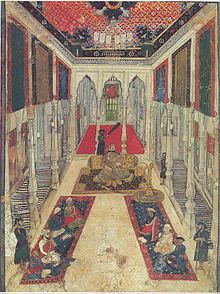
Back Durbar German دربار (هندی) Persian Darbâr French दरबार (अदालत) Hindi Durbar ID Durbar Italian ದರ್ಬಾರು Kannada Durbar Dutch ਦਰਬਾਰ Punjabi دربار PNB
This article needs additional citations for verification. (April 2014) |


Durbar is a Persian-derived term (from Persian: دربار, romanized: darbār) referring to the noble court of a king or ruler or a formal meeting where the king held all discussions regarding the state. It was used in South Asia for a ruler's court or feudal levy. A durbar may be either a feudal state council for administering the affairs of a princely state, or a purely ceremonial gathering, as was increasingly the case during British rule in India.[1]
The most famous durbars belonged to powerful emperors and kings. In the north of India, cities like Baroda, Gwalior, Udaipur, Jaipur, Jodhpur, Jaisalmer, Agra, and the city of Lahore in Pakistan have palaces and forts that adorn such halls. The Mughal emperor Akbar had two halls—one for his ministers, and the other for the general public. Usually, durbar halls are lavishly decorated with the best possible materials available at the time.
In the south of India, the Mysore Palace had a number of such halls, especially the Peacock Hall, having colour tinted glasses imported from Belgium, which were used for marriage ceremonies. The Durbar Hall in the Khilawat Mubarak, in the city of Hyderabad, Telangana, was the Durbar Hall of the Nizams of Hyderabad.
Beneath the main dome of the Rashtrapati Bhavan is the Grand Durbar Hall. As the building now serves as the presidential palace, many state functions are currently carried out there, presided upon by the President of India.